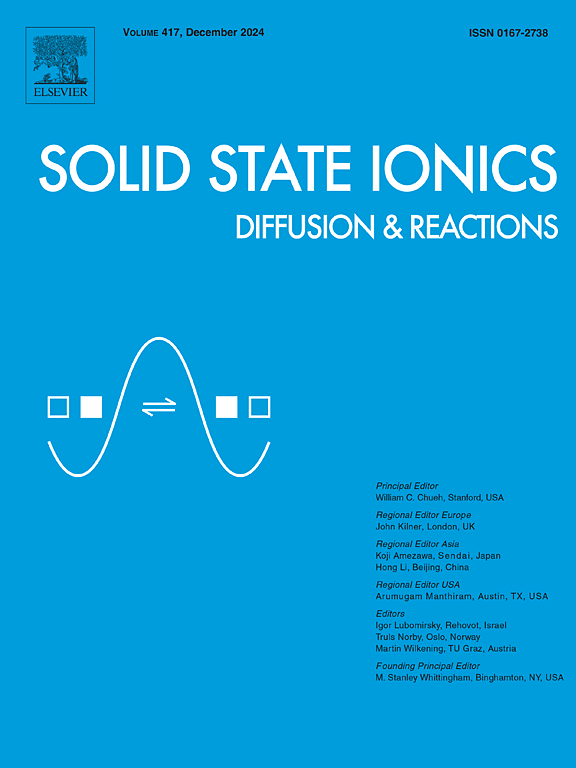Mimicking Na+ ion transport in superionic Na3PS4 solid electrolytes through amorphization
IF 3
4区 材料科学
Q3 CHEMISTRY, PHYSICAL
引用次数: 0
Abstract
Identifying solid electrolytes with superior Na+ ion conductivity at room temperature is critical for designing safe and high energy density solid-state batteries with enhanced rate capabilities. Sodium thiophosphate (Na3PS4) based solid electrolytes have shown excellent promise with relatively high ionic conductivity. In particular, the orthorhombic γ – Na3PS4 phase exhibits superionic behavior (ionic conductivity ∼10–50 mS/cm) compared to that of the cubic (ionic conductivity ∼0.1 mS/cm) and tetragonal (ionic conductivity ∼0.001–0.01 mS/cm) Na3PS4 phases at room temperature. However, the reported γ – Na3PS4 phase is stable only at high temperatures and, therefore, does not contribute towards improving ionic conductivity at room temperature. In this study, we report ab initio molecular dynamics calculations to gain fundamental insights into the superionic behavior of the γ – Na3PS4 phase. These insights were applied to simulate and develop correlations between structure and ionic conductivity in amorphous Na3PS4 glassy electrolytes. Our results indicate that the concentration of local structural units in the glasses impact the ionic conductivity. We found out that glasses with a relatively higher concentration of isolated PS4 and PS3 units exhibit greater Na+ ion diffusivity at temperatures below 500 K. Tuning the concentration of these structural units can be achieved through appropriate heat treatment of the amorphous Na3PS4 to achieve high ionic conductivity for novel glass-ceramic type Na3PS4 solid electrolytes at room temperature. Overall, our results qualitatively suggest guidelines for achieving superior ionic conductivity in Na3PS4 glass-ceramic electrolytes.
通过非晶化模拟超离子Na3PS4固体电解质中Na+离子的输运
确定在室温下具有优异Na+离子导电性的固体电解质对于设计具有增强倍率能力的安全和高能量密度固态电池至关重要。硫代磷酸钠(Na3PS4)基固体电解质具有较高的离子电导率,具有良好的应用前景。特别是,在室温下,与立方(离子电导率~ 0.1 mS/cm)和四方(离子电导率~ 0.001 ~ 0.01 mS/cm)的Na3PS4相相比,正交γ - Na3PS4相表现出超离子行为(离子电导率~ 10-50 mS/cm)。然而,所报道的γ - Na3PS4相仅在高温下稳定,因此对室温下离子电导率的提高没有贡献。在这项研究中,我们报告从头算分子动力学计算,以获得对γ - Na3PS4相超离子行为的基本见解。这些见解被应用于模拟和发展非晶Na3PS4玻璃电解质中结构和离子电导率之间的相关性。结果表明,玻璃中局部结构单元的浓度对离子电导率有影响。我们发现,相对较高的分离PS4和PS3单元浓度的玻璃在低于500 K的温度下表现出更大的Na+离子扩散率。通过对非晶态Na3PS4进行适当的热处理,可以调节这些结构单元的浓度,从而使新型玻璃陶瓷型Na3PS4固体电解质在室温下具有较高的离子电导率。总的来说,我们的结果定性地提出了在Na3PS4玻璃陶瓷电解质中实现优异离子电导率的指导方针。
本文章由计算机程序翻译,如有差异,请以英文原文为准。
求助全文
约1分钟内获得全文
求助全文
来源期刊

Solid State Ionics
物理-物理:凝聚态物理
CiteScore
6.10
自引率
3.10%
发文量
152
审稿时长
58 days
期刊介绍:
This interdisciplinary journal is devoted to the physics, chemistry and materials science of diffusion, mass transport, and reactivity of solids. The major part of each issue is devoted to articles on:
(i) physics and chemistry of defects in solids;
(ii) reactions in and on solids, e.g. intercalation, corrosion, oxidation, sintering;
(iii) ion transport measurements, mechanisms and theory;
(iv) solid state electrochemistry;
(v) ionically-electronically mixed conducting solids.
Related technological applications are also included, provided their characteristics are interpreted in terms of the basic solid state properties.
Review papers and relevant symposium proceedings are welcome.
 求助内容:
求助内容: 应助结果提醒方式:
应助结果提醒方式:


